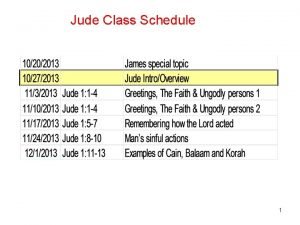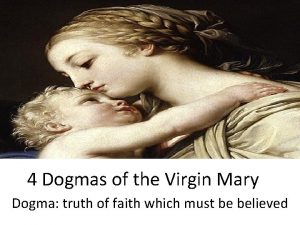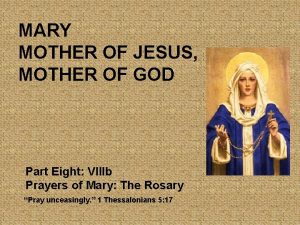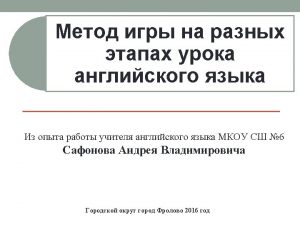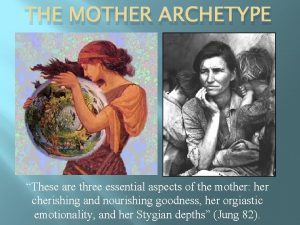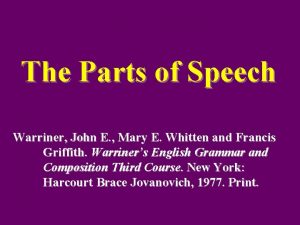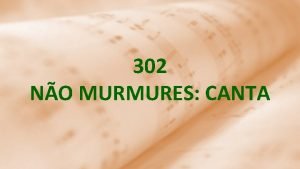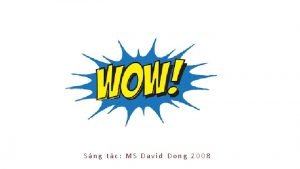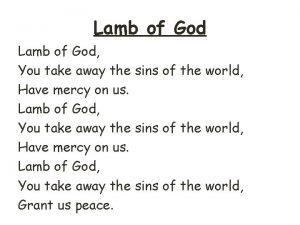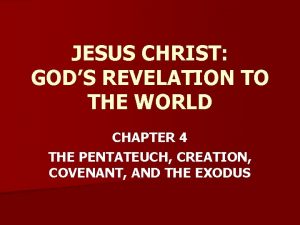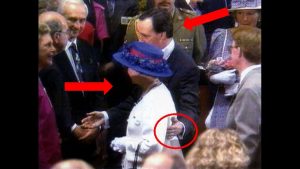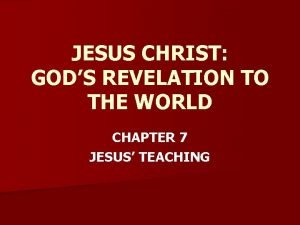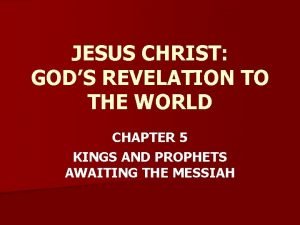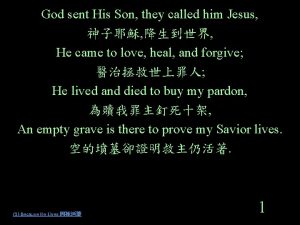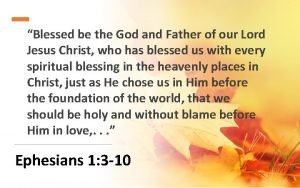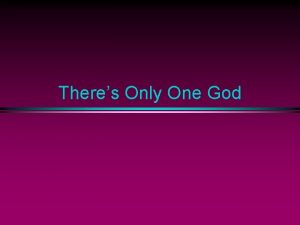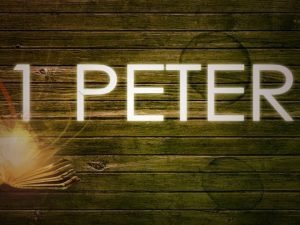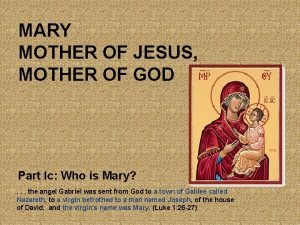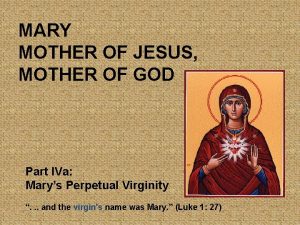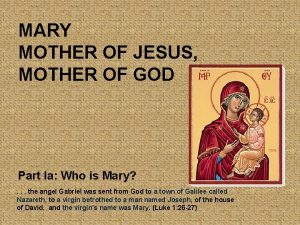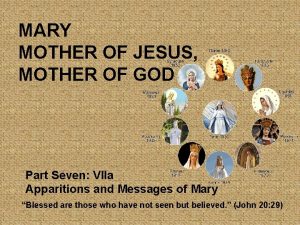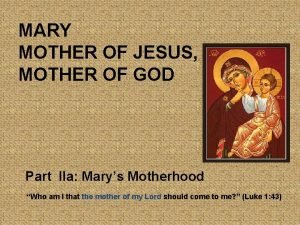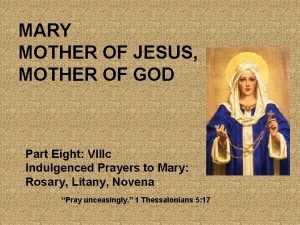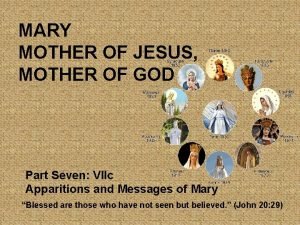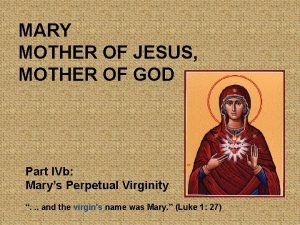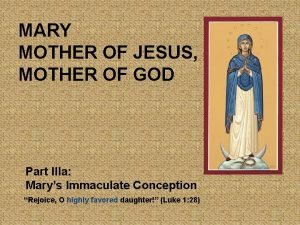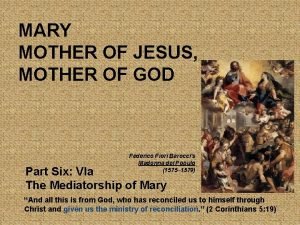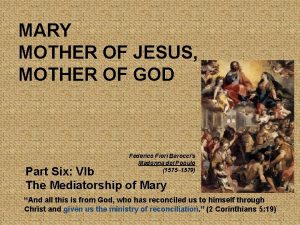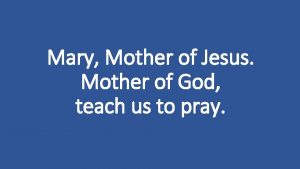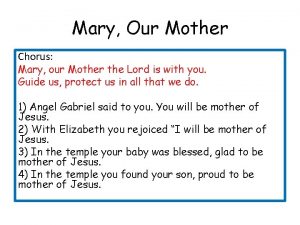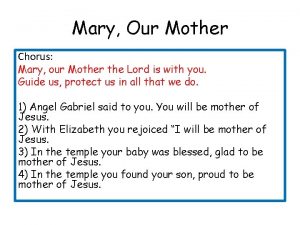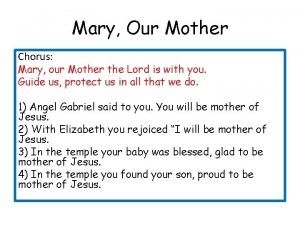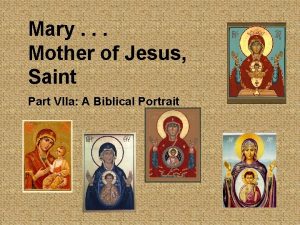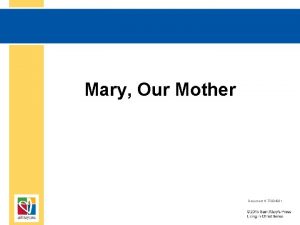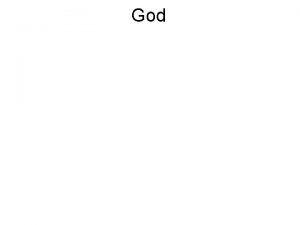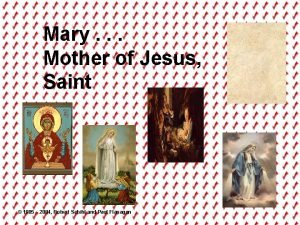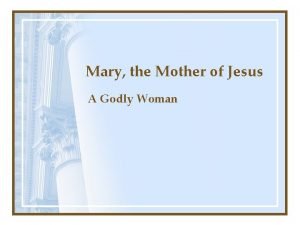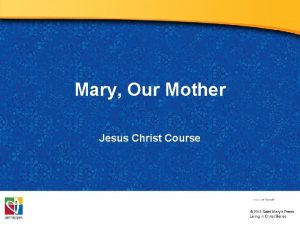MARY MOTHER OF JESUS MOTHER OF GOD Part




























- Slides: 28

MARY MOTHER OF JESUS, MOTHER OF GOD Part IIc: Mary’s Motherhood “Who am I that the mother of my Lord should come to me? ” (Luke 1: 43)

Matthew 1: 1 -16 Descending from Abraham Luke 3: 23 -38 Ascending to Adam

The Genealogy of Jesus Christ through Mary Jesus Christ is a descendant from David. If He is from the line of David, then certainly Joseph could not be of his immediate paternal bloodline since Joseph was not his natural father. The bloodline could only be traced through His mother, Mary. She alone provided 100% of His genetic material, and thus provided the “flesh of the offspring of David. ” Romans 1: 3 . . . concerning His Son who was born to Him according to the flesh of the offspring of David. Matthew 1: 1 The book of the origin of Jesus Christ, the Son of David, the Son of Abraham. John 7: 42 Does not the Scripture say that it is of the offspring of David, and from Bethlehem, the village where David lived, that the Christ is to come.

2 Timothy 2: 8 Remember that Jesus Christ rose from the dead and was descended from David. Luke 1: 32 God will give Him the throne of David, His father, and He shall be king over the house of Jacob forever. Galatians 4: 4 But when the fullness of time came, God sent His Son, born of a woman, born under the law. See also all of these verses which refer to Jesus Christ as the Son of David: Matt 9: 27, 12: 23, 15: 22, 20: 30 -31, 21: 9, 21: 15, 22: 42, 22: 45, Mark 10: 47 -48, 12: 35, 12: 37, Luke 18: 38 -39, Luke 20: 44.

Jesus Christ is descended from David, but through the genealogy of Mary it is only implied. However, Jesus had no human father. There was no human exchange for the conception of Jesus and so the human bloodline cannot be traced through Joseph. Jewish law required that genealogies were to be through the line of the males, and not the females. Numbers 1: 17 -18 So Moses and Aaron took these men who had been designated, and assembled the whole community on the first day of the second month. Every man of twenty years or more then declared his name and lineage according to clan and ancestral house.

Accurate records of genealogies were very important to the Jews. First Chronicles contains eleven chapters of genealogies! Jewish historian, Josephus, wrote that Public Records recorded genealogies from the oldest to the youngest, and Private Records went from the youngest back to the oldest, and these genealogies were passed down through the generations. This was done in part in order to prevent unqualified persons from gaining positions through their ancestry. (See Ezra 2: 61 -63, and Nehemiah 7: 63 -65 where some priests were rejected because they could not prove their Levitical ancestry. ) Because the custom was of using male genealogies only, then how could an ancestral line of Jesus be shown through Mary? It appears that God left a convenient loophole in this law that would allow women to be included in the ancestral line if they met two stringent conditions. Numbers 27: 8 Therefore, tell the Israelites; If a man dies without leaving a son, you shall let his heritage pass on to his daughter.

Numbers 36: 6 -7 This is what the Lord commands with regard to the daughters of Salphahad: They marry anyone they please, provided they marry into a clan of their ancestral tribe, so that no heritage of the Israelites will pass from one tribe to another, but all the Israelites will retain their own ancestral heritage. Now it has to be shown that (1) the father of Mary had no sons; (2) Mary married within her own tribe of Judah. Genesis 49: 8 -12 You, Judah, shall your brothers praise--your hand on the neck of your enemies; the sons of your father shall bow down to you. Judah, like a lion's whelp, you have grown up on prey, my son. He crouches like a lion recumbent, the king of beasts--who would dare rouse him? The scepter shall never depart from the mace from between his legs, while tribute is brought to him, and he receives the people's homage. He tethers his donkey to the vine, his purebred ass to the choicest stem. In wine he washes his garments; his robe in the blood of grapes. His eyes are darker than wine, and his teeth are whiter than milk.

The first condition: did Mary have brothers? There is no record of it. The bible does not mention brothers, but it does say she had a sister. John 19: 25 Now there were standing by the cross of Jesus his mother and his mother's sister, Mary of Cleophas, and Mary Magdalene. It is thought that the sister of Mary was Salome, the wife of Zebedee and the mother of James and John (Matthew 20: 20, Mark 15: 40). In the Jewish culture in those days, the mother who was widowed (assuming that Joseph was dead at this time) would have gone to her father, or brother, or to her other children. Apparently, her father was dead, she had no brothers, and she had no other children, so Jesus gave her to John 19: 26 -27 When Jesus saw his mother and the disciple there whom he loved, he said to his mother, “Woman, behold, your son. ” Then he said to the disciple, “Behold, your mother. ” And from that hour the disciple took her into his home.

The words of Jesus in John 19: 27, and lack of evidence of male siblings, strongly suggest that the first condition was satisfied. The secondition is a bit more involved: Mary married within her own tribe of Judah. Matthew 1: 1 -16 The book of the origin of Jesus Christ, the Son of David, the son of Abraham begot Isaac, Isaac begot Jacob, Jacob begot Judah. . . Jesse begot David the king. And David the king begot Solomon of the former wife of Uriah (Bathsheba). This genealogy continues. Matthew 1: 16 And Jacob begot Joseph, the husband of Mary, and of her was born Jesus who is called Christ. The descendant of David is Solomon. In Luke's genealogy, a different son of David, Nathan, is listed.

Matthew clearly shows that the bloodline of Joseph does go back to the tribe of Judah, and through King David. If Jesus Christ is the Son of David, then His mother, Mary has to be also of the house of David and therefore by implication, of the tribe of Judah. As already seen in Romans 1: 3, it could have not been said that the Son was born according to the flesh of the offspring of David unless Mary were of Davidic descent. Luke 1: 26 -27 Now in the sixth month the angel Gabriel was sent from God to a town of Galilee called Nazareth, to a virgin betrothed to a man named Joseph, of the house of David, and the virgin's name was Mary. It has been shown that Mary is implied as being of the house of David in Luke 1: 32. If she were not of the house of David, then clearly, Jesus Christ could not have been a descendant of David as do so many verses attest. She married within her tribe (by implication) and so the secondition appears to be satisfied.

Consequently, both conditions for the bloodline to continue through the female line are satisfactorily met by Mary if it can be shown that she is of the same tribe of Judah through David, as is her spouse, Joseph. Review the bloodline of Joseph with some added observations. Matthew addressed his Gospel to the Jews, who followed the Law of Moses (Mosaic Law). He wrote the genealogy of Jesus Christ in Matt 1: 1 -17, and he was careful to meet the legal requirements of the Mosaic Law. His was of the Public Record as explained earlier. In it he begins with Abraham and shows the line going through David and then Solomon and all the way down to Jesus Christ. In verse 16, “And Jacob begot Joseph, the husband of Mary, and of her was born Jesus who is called Christ. ” Matthew depicts Jesus Christ as “the Messiah. ”

Clearly Matthew said that the blood father (begot) of Joseph was Jacob. Matthew had satisfied the Mosaic Law by showing the male ancestry of Jesus by going through Joseph instead of Mary. Remember this genealogy shows the legal, or royal, or Public Record, of descent and not the human descent. More evidence that Matthew shows the legal line of descent is in Matthew 1: 11 -12 where a man named Jechonias is mentioned. Jeremiah 22: 28 -30 regarding Jechonias, states, “. . . for there shall not be a man of his seed that shall sit on the throne of David. . . ”

Luke has quite a different account of the genealogy of Jesus Christ. He wrote his Gospel to address the Gentile pagans who were not under the Mosaic Law, and for the most part were unfamiliar with it. He was also a physician, (Col 4: 14). His interest, no doubt, was not in the legal aspect of the genealogy of Jesus Christ, but of the human or natural bloodline, by depicting Jesus as the “Son of Man. ” Luke's genealogy begins with Jesus Christ and goes backward in time, just the opposite of Matthew who started back and came forward. Luke's genealogy follows the custom of Private Records as explained. Notice in Luke 3: 23 -38, that Luke's genealogy does go from Jesus Christ, through David, and back to Judah, continuing all the way to Adam, and then to God. By doing this he shows a tie between the “New Adam” (1 Corinthians 15: 45) and the first Adam. However, Luke shows the descendant of David to be Nathan, and not Solomon, as does Matthew. This alludes to the possibility that Luke's genealogy is for a different person other than Joseph. Look closer at verse 23 with three different Bible translations.

“And Jesus Himself, when He began His work, was about thirty years of age, -being as was supposed- the Son of Joseph, the Son of Heli, the Son of Matthat. ” Challoner-Rheims-Confraternity (Confraternity of Christian Doctrine) “When Jesus began His ministry he was about thirty years of age. He was the Son, as was thought, of Joseph, the son of Heli, the son of Matthat. . . ” New American Bible “And Jesus Himself began to be about thirty years of age, being (as was supposed) the Son of Joseph, which was the Son of Heli, which was the son of Matthat…” King James This verse at first reading might seem to say that there is something amiss.

This verse appears to say that the father of Joseph is Heli, yet in Matthew that it was Jacob. How can Joseph have two fathers? Matthew 1: 16 And Jacob begot Joseph, the husband of Mary, and of her was born Jesus who is called Christ. In many places in Holy Scripture one must revert to the underlying Greek text in order to fully understand the verse. The Greek word used for “as was supposed, or, as was thought” is “nomizo, ” which means: 1. To hold by custom or usage. 2. To follow by custom or usage. 3. It is the custom. 4. It is the received usage. 5. To deem, to think, to suppose.

This matter can be made clearer by interpreting the verse as: “When Jesus began His ministry he was about thirty years of age. He was the Son (so it was thought, of Joseph) of Heli. ” The underlying Greek text supports this interpretation. Luke 3: 23 Καὶ αὐτὸς ἦν ὁ Ἰησοῦς ὡσεὶ ἐτῶν τριάκοντα ἀρχόμενος, ὢν, And Himself was Jesus about years (old) thirty beginning, being, ὡς ἐνομίζετο, υἱός Ἰωσήφ, τοῦ Ἠλί, τοῦ Ματθάν, as was supposed, the son of Joseph, of Heli, of Matthat. . . The word 'son' before Heli, is not in the Greek text. So in order to trace the bloodline of Jesus through Heli, one would first have to go through Mary, His mother. This shows that Heli would be the blood father of Mary, and the father-in-law of Joseph. Even though the name of Mary is not listed, in order to comply with Jewish custom, it is certainly implied.

Matthew 1: 15, shows that Matthan is the father of Jacob, and Luke 3: 23 -24, shows that Matthat was the father of Heli. It is not known if Matthan and Matthat are the same person. They may well be the same person. If they are the same person that would indicate that Jacob and Heli could be brothers if they had the same mother, or half brothers if they had different mothers, or one of them could have even been adopted from the tribe of Judah. Julius Africanus (160 -240 AD) wrote in his Epistle to Aristides that Jacob and Heli were half brothers. The Bible makes no distinction between genetic birth and adoption. In 2 Samuel 6: 23, where Michol the daughter of Saul and the wife of David (1 Samuel 18: 27) had no children. Yet in 2 Samuel 21: 8, it says Michol had five sons. In reality, they were adopted sons of Merob. Jacob was the genetic father of Joseph. Heli, the father of Mary, was Joseph's father in law, her legal father.

Additionally, 1. Luke was devoted to the Blessed Virgin Mary as evidenced by his beautiful accounts of her in his Gospel. Knowing full well that Joseph was not the human father of Jesus Christ, and being a physician, he would naturally show the ancestral blood line to go through Mary. 2. Matthew's genealogy lists three breaks in the Mosaic Law. This indicates in the first few verses of the New Testament, that the Old Covenant, and with it the Mosaic Law, is coming to an end, being fulfilled (Matthew 5: 17), and soon to be superseded by the New Covenant of Jesus Christ. a. Females are listed. Tamar (Genesis 38: 6, 1 Chronicles 2: 4), Rahab (Joshua 2: 1, 17), Ruth, book of Ruth, Bathsheba’ former wife of Uriah (2 Samuel 11: 12, 24). b. Sinners are listed. Tamar, a deceiver, Rahab, a harlot, Bathsheba, an adulteress, Solomon, idolatry. By naming sinners, God has shown that His ways are not our ways.

c. Gentiles are listed. Tamar, a Canaanite, Rahab, a Canaanite, Ruth, a Moabite, Bathsheba, a Hittite. Foreigners like these symbolized God's desire to save all, with no distinction between Jew and Gentile, Colossians 3: 11. 3. What about Joachim? Was he not the father of Mary with Anne as her mother? Joachim is mentioned as the father of Mary in the following apocryphal books: The Protoevangelium of James, The Gospel of the Nativity of the Blessed Virgin, and The Book of the Nativity of the Blessed Virgin Mary. Joachim is another form of Joakim and Eliakim. 2 Kings 23: 34 And Pharao Nechao made Eliakim the son of the Josias king in the room of Josias his father, and turned his name to Joakim. . . 2 Chronicles 36: 4 And he made Eliakim his brother king in his stead over Judah and Jerusalem; and he turned his name to Joakim…

Subsequently, over the centuries, it is probable that the name Eliakim was shortened to Eli or Heli is merely the Greek form of the Hebrew Eli. The high priest in 1 Samuel 1: 3 is called Heli in the Challoner-Rheims, and Eli in the New American Bible. You can see that the differences in translations will show different names at times. There are many name changes and different spellings of persons names in Scripture. For example, Matthew himself, was also called Levi in Luke 5: 27, and in Mark 2: 14. Joachim and Heli appear to be one and the same person. Joseph did adopt Jesus as his son by fulfilling the ancient law for adoptions at the time of Christ. The adopting father had two requirements: to name the child, and to teach the child his trade or craft. We know Joseph fulfilled these requirements. Adapted from home. inreach. com/bstanley/general. htm

The Family Relationships of Jesus Mark 6: 1 -6 He departed from there and came to his native place, accompanied by his disciples. When the Sabbath came he began to teach in the synagogue, and many who heard him were astonished. They said, “Where did this man get all this? What kind of wisdom has been given him? What mighty deeds are wrought by his hands! Is he not the carpenter, the son of Mary, and the brother of James and Joses and Judas and Simon? And are not his sisters here with us? ” And they took offense at him. Jesus said to them, “A prophet is not without honor except in his native place and among his own kin and in his own house. ” So he was not able to perform any mighty deed there, apart from curing a few sick people by laying his hands on them. He was amazed at their lack of faith.

Matthew 27: 56 Among them were Mary Magdalene and Mary the mother of James and Joseph, and the mother of the sons of Zebedee. Mark 15: 40 There were also women looking on from a distance. Among them were Mary Magdalene, Mary the mother of the younger James and of Joses, and Salome. Mark 16: 1 When the Sabbath was over, Mary Magdalene, Mary, the mother of James, and Salome bought spices so that they might go and anoint him. Luke 24: 10 The women were Mary Magdalene, Joanna, and Mary the mother of James; the others who accompanied them also told this to the apostles,

Jude 1: 1 Jude, a slave of Jesus Christ and brother of James, to those who are called, beloved in God the Father and kept safe for Jesus Christ: John 19: 25 Standing by the cross of Jesus were his mother and his mother's sister, Mary the wife of Clopas, and Mary of Magalia. Matthew 10: 2 -4 The names of the twelve apostles are these: first, Simon called Peter, and his brother Andrew; James, the son of Zebedee, and his brother John; Philip and Bartholomew, Thomas and Matthew the tax collector; James, the son of Alphaeus, and Thaddeus; Simon the Cananean, and Judas Iscariot who betrayed him. Luke 6: 16 When day came, he called his disciples to himself, and from them he chose Twelve, whom he also named apostles: Simon, whom he named Peter, and his brother Andrew, James, John, Philip, Bartholomew, Matthew, Thomas, James the son of Alphaeus, Simon who was called a Zealot, and Judas the son of James, and Judas Iscariot, who became a traitor.

Matthew 13: 54 -56 He came to his native place and taught the people in their synagogue. They were astonished and said, "Where did this man get such wisdom and mighty deeds? Is he not the carpenter's son? Is not his mother named Mary and his brothers James, Joseph, Simon, and Judas? Are not his sisters all with us? Where did this man get all this? " John 19: 25 Standing by the cross of Jesus were his mother and his mother's sister, Mary the wife of Clopas, and Mary of Magdala. When Jesus saw his mother and the disciple there whom he loved, he said to his mother, “Woman, behold, your son. ” Then he said to the disciple, “Behold, your mother. ” And from that hour the disciple took her into his home.

Crucifixion by Andrea Mantegna c. 1457 In the four gospels there a total of four women listed as being at the foot of the cross and tomb of Jesus at Calvary: Mary, the mother of Jesus Mary Magdalene, listed in all four gospels Mary (the wife of Clopas), the mother of James (the younger), Joseph (Joses), and Salome Joanne, the sister of Jesus' mother (Jesus' aunt) who was the mother of James and John, the sons' of Zebedee

THE MOTHER OF JESUS MATTHEW MARK LUKE JOHN MARY OF MAGDELA “There were many “Mary women Magdalene” there” “There were also women “Mary looking on Magdalene” from a distance” “The women who had “Mary come from Magdalene” Galilee with him followed behind” “his mother” “Mary of Magdala” SALOME/ JOANNA MARY THE WIFE OF CLOPAS “the mother of the “Mary the mother sons of Zebedee” of James and Joseph” “Salome” “Mary the mother of the younger James and of Joses” “Joanna” “Mary the mother of James” “his mother's sister” “Mary the wife of Clopas”

Zachariah m. Elizabeth SIBLING/ COUSIN Anna m. Joachim ? John the Baptist SIBLING/ COUSIN Joanna m. Zebedee (aka Salome) Mary m. Joseph (aka Miriam) Mary m. Clopas (m. Unknown) (aka Alphaeus) Matthew the Apostle Jesus Joses James John the Great the Apostle “Beloved Disciple” the Evangelist the Apostle (aka Joseph) 3 Sisters James the Younger “the Righteous” Judas 1 st Bishop of Jerusalem aka Jude Author of the Epistle aka Thaddeus the Apostle Author of the Epistle the Apostle The Family Relationships of Jesus Simon the Zealot the Cananean Succeeded James as 2 nd Bishop of Jerusalem the Apostle

End of Mary the Series, Her Motherhood Part IIc Go to Mary the Series, The Immaculate Conception Part IIIa
 The siblings of jesus
The siblings of jesus Dogma mary mother of god
Dogma mary mother of god Prayer to mary mother of god
Prayer to mary mother of god Jesus is the sweetest name i know
Jesus is the sweetest name i know Jesus in the morning
Jesus in the morning Mary wollstonecraft mary a fiction
Mary wollstonecraft mary a fiction Mary magdalene jesus wife
Mary magdalene jesus wife Running shoe tongue slides
Running shoe tongue slides Good mother archetype examples
Good mother archetype examples Mary part of speech
Mary part of speech Jesus you are my lord jesus you are my everything
Jesus you are my lord jesus you are my everything Em vez de murmurares canta
Em vez de murmurares canta Jesus jesus how i trust him
Jesus jesus how i trust him Lebrnslauf
Lebrnslauf @jesus david pineda j:men. swap part 1
@jesus david pineda j:men. swap part 1 Lamb of god takes away the sins of the world
Lamb of god takes away the sins of the world Love love jesus is love god greatest gift lyrics
Love love jesus is love god greatest gift lyrics Jesus christ god's revelation to the world answers
Jesus christ god's revelation to the world answers Jesus christ god's revelation to the world
Jesus christ god's revelation to the world Who being in the very nature god
Who being in the very nature god Jesus christ god's revelation to the world
Jesus christ god's revelation to the world Jesus christ god's revelation to the world chapter 5
Jesus christ god's revelation to the world chapter 5 God sent his son they called him jesus
God sent his son they called him jesus Blessed be the god and father of our lord jesus
Blessed be the god and father of our lord jesus Jesus christ god's revelation to the world
Jesus christ god's revelation to the world Direct voice
Direct voice 馮定華
馮定華 Only one god jesus
Only one god jesus Blessed be the god and father
Blessed be the god and father
